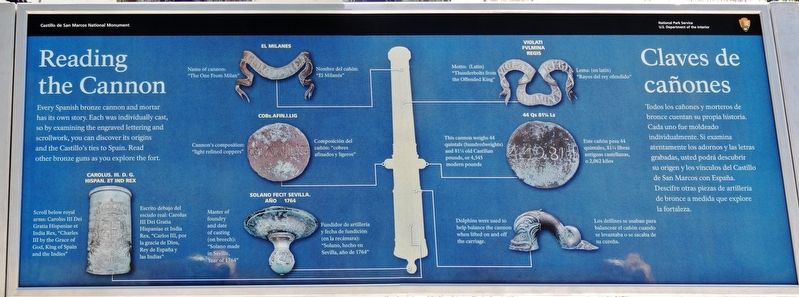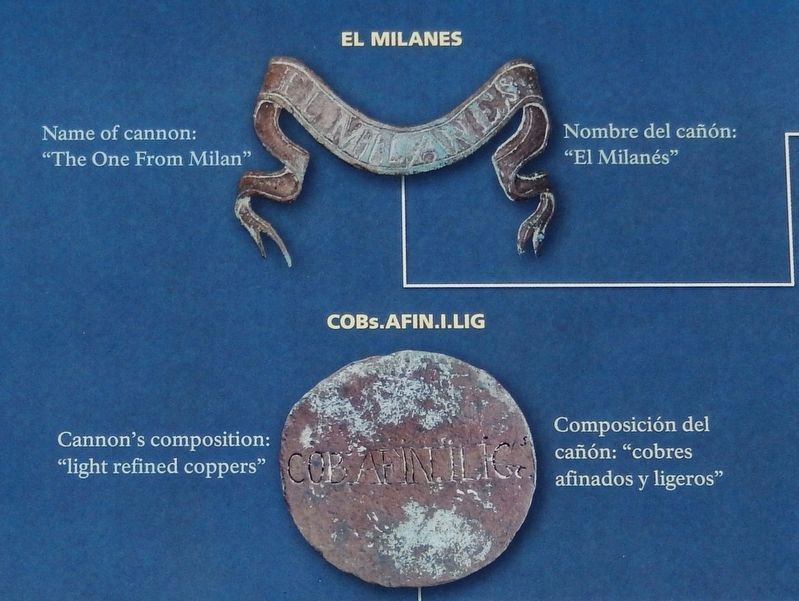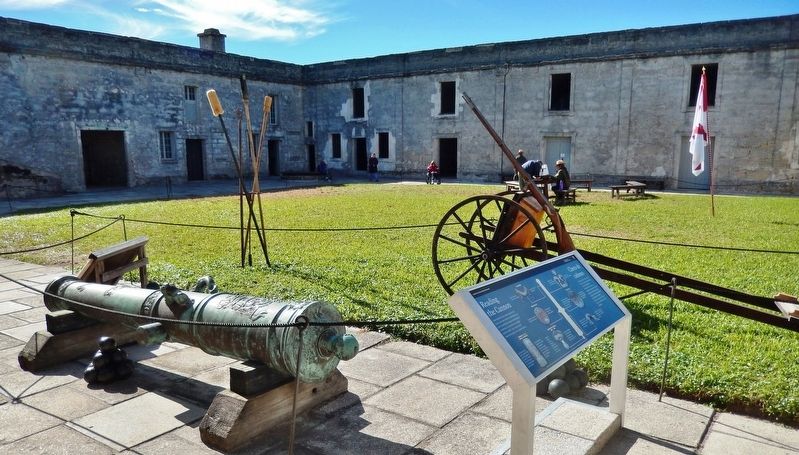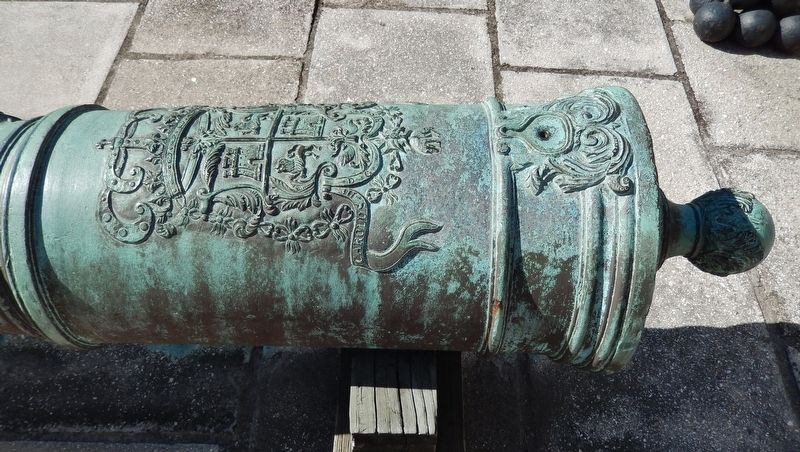Historic District in St. Augustine in St. Johns County, Florida — The American South (South Atlantic)
Reading the Cannon / Claves de cañones
Castillo de San Marcos National Monument
Erected 2018 by National Park Service, U.S. Department of the Interior.
Topics. This historical marker is listed in these topic lists: Colonial Era • Forts and Castles • Hispanic Americans.
Location. 29° 53.875′ N, 81° 18.684′ W. Marker is in St. Augustine, Florida, in St. Johns County. It is in the Historic District. Marker can be reached from the intersection of South Castillo Drive (State Road A1A) (Business U.S. 1) and Cuna Street, on the right when traveling north. Marker is located on the Castillo de San Marcos National Monument grounds, near the northeast corner of the fort's Plaza de Armas. Touch for map. Marker is at or near this postal address: 1 South Castillo Drive, Saint Augustine FL 32084, United States of America. Touch for directions.
Other nearby markers. At least 8 other markers are within walking distance of this marker. Indian Prisoners (a few steps from this marker); Cannon (a few steps from this marker); Chapel of St. Mark (a few steps from this marker); Matanzas Bay (a few steps from this marker); St. Charles Bastion (a few steps from this marker); Northern Defense Lines (a few steps from this marker); Plaza-Courtyard (a few steps from this marker); British Quarters (a few steps from this marker). Touch for a list and map of all markers in St. Augustine.
More about this marker. Marker is a large rectangular composite plaque, mounted horizontally on waist-high metal posts.
Related markers. Click here for a list of markers that are related to this marker. Castillo de San Marcos National Monument
Also see . . .
1. Arms & Armament. Both bronze and iron were used to make cannons throughout the 18th and 19th centuries. The non-rusting bronze was preferred for the damp environments of ships and seacoast forts. Early Spanish bronze artillery could also be described as beautiful works of art. Today, all the bronze guns at the Castillo are covered in a green
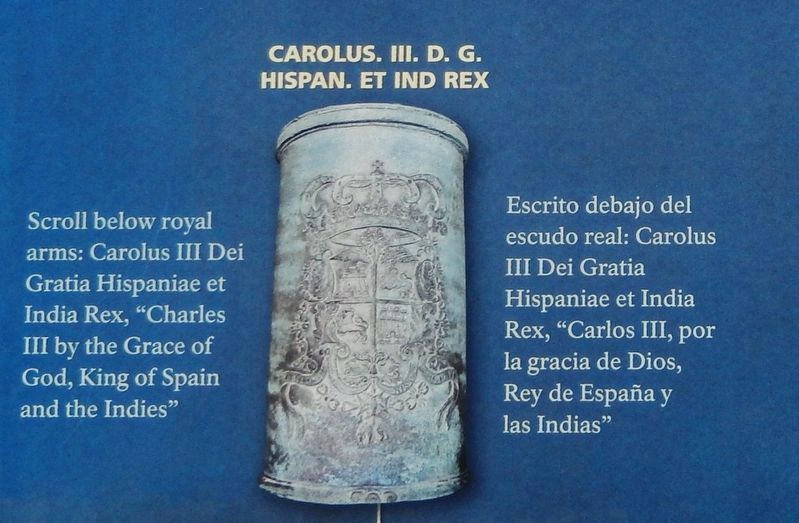
2. Marker detail: CAROLUS. III. D. G. HISPAN. ET IND REX
Scroll below royal arms: Carolus III Dei Gratia Hispaniae et India Rex, “Charles III by the Grace of God, King of Spain and the Indies”
Escrito debajo del escudo real: Carolus III Dei Gratia Hispaniae et India Rex, “Carlos III, por la gracia de Dios, Rey de España y las Indias”
Escrito debajo del escudo real: Carolus III Dei Gratia Hispaniae et India Rex, “Carlos III, por la gracia de Dios, Rey de España y las Indias”
2. Castillo de San Marcos Artillery Tour. Inventory and location of artillery on exhibit at Castillo de San Marcos. (Submitted on December 16, 2018, by Cosmos Mariner of Cape Canaveral, Florida.)
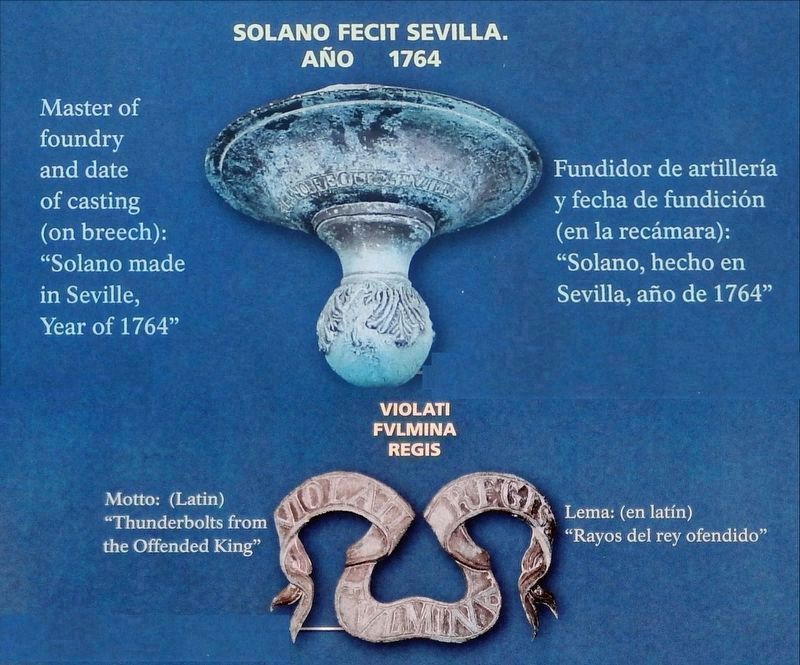
Photographed By Cosmos Mariner, December 12, 2018
4. Marker detail: SOLANO FECIT SEVILLA. Año 1764
Master of foundry and date of casting (on breech): "Solano made in Seville, Year of 1764"
Fundidor de artillería y fecha de fundición (en la recámara): "Solano, hecho en Sevilla, año de 1764"
VIOLATI FVLMINA REGIS
Motto: (Latin) "Thunderbolts from the Offended King"
Lema: (en latín) "Rayos del rey ofendido"
Fundidor de artillería y fecha de fundición (en la recámara): "Solano, hecho en Sevilla, año de 1764"
VIOLATI FVLMINA REGIS
Motto: (Latin) "Thunderbolts from the Offended King"
Lema: (en latín) "Rayos del rey ofendido"
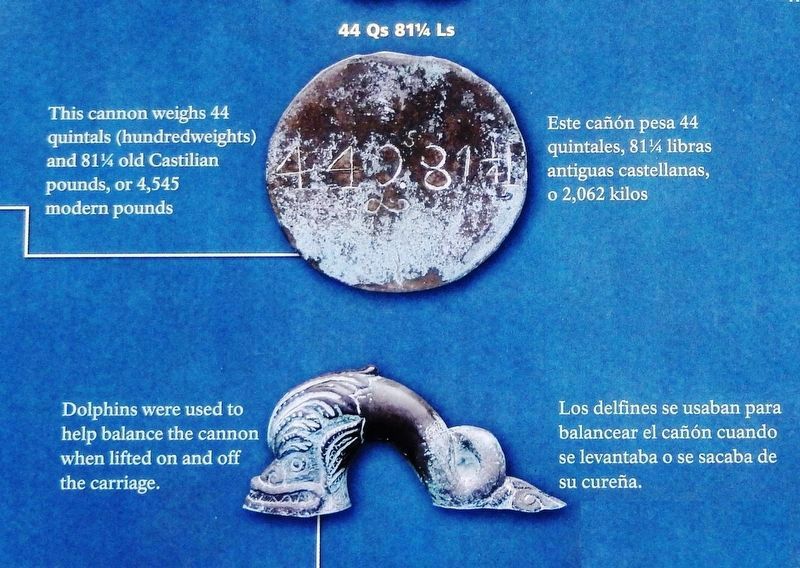
Photographed By Cosmos Mariner, December 12, 2018
5. Marker detail: 44 Qs 81-1/4 Ls
This cannon weighs 44 quintals (hundredweights) and 81-1/4 old Castilian pounds, 3 or 4,545 y modern pounds
Este cañón pesa 44 quintales, 81-1/4 libras antiguas castellanas, o 2,062 kilos
Dolphins
Dolphins were used to help balance the cannon when lifted on and off the carriage.
Los delfines se usaban para balancear el cañón cuando se levantaba o se sacaba de su cureña.
Este cañón pesa 44 quintales, 81-1/4 libras antiguas castellanas, o 2,062 kilos
Dolphins
Dolphins were used to help balance the cannon when lifted on and off the carriage.
Los delfines se usaban para balancear el cañón cuando se levantaba o se sacaba de su cureña.
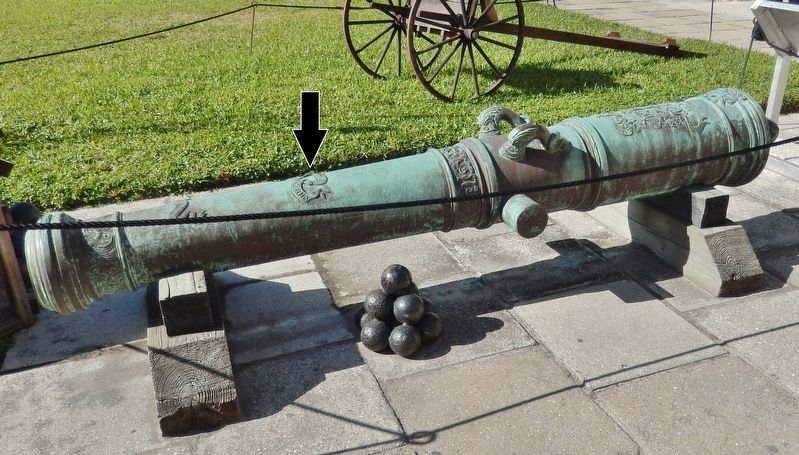
Photographed By Cosmos Mariner, December 12, 2018
7. "El Milanés" cannon (on exhibit beside marker)
Two of the Castillo's cannons have a banner that reads “Violati Fulmina Regis” (thunderbolts of an offended/angry king). On this cannon, that banner is engraved on the top of the middle portion of the barrel.
Credits. This page was last revised on August 20, 2020. It was originally submitted on December 15, 2018, by Cosmos Mariner of Cape Canaveral, Florida. This page has been viewed 369 times since then and 46 times this year. Last updated on December 23, 2018, by Cosmos Mariner of Cape Canaveral, Florida. Photos: 1. submitted on December 15, 2018, by Cosmos Mariner of Cape Canaveral, Florida. 2, 3. submitted on December 16, 2018, by Cosmos Mariner of Cape Canaveral, Florida. 4, 5. submitted on December 28, 2018, by Cosmos Mariner of Cape Canaveral, Florida. 6, 7, 8. submitted on December 16, 2018, by Cosmos Mariner of Cape Canaveral, Florida. • Andrew Ruppenstein was the editor who published this page.
